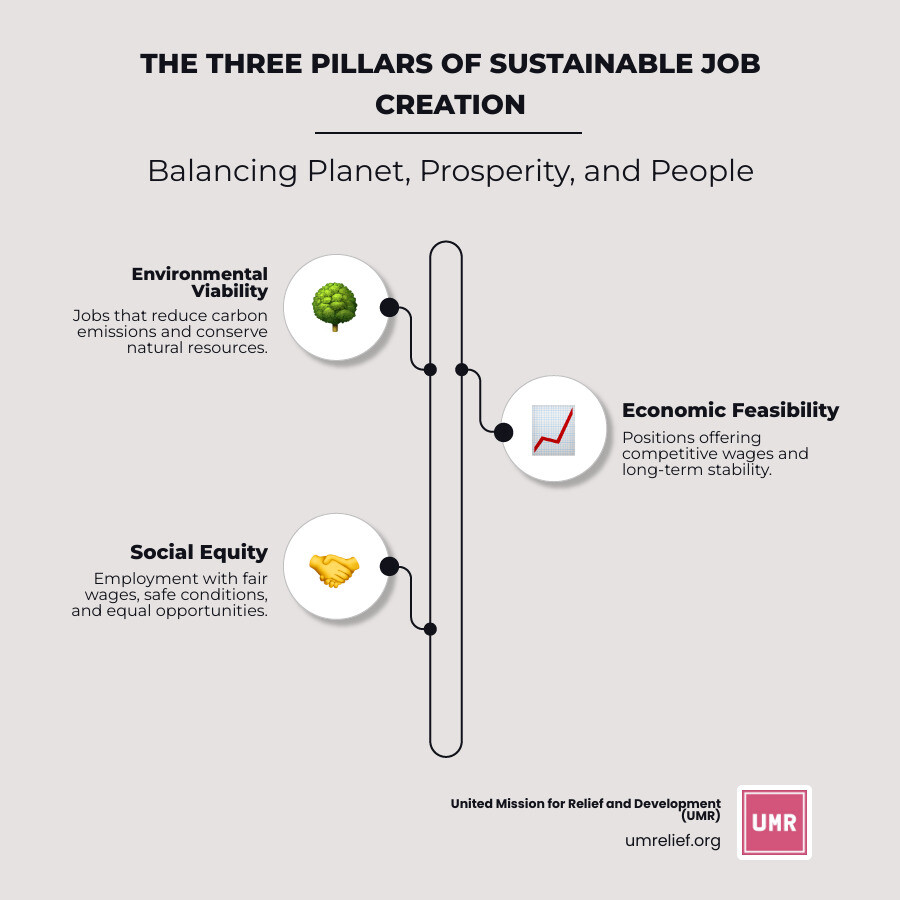Sustainable Job Creation: 3 Pillars of Progress
Why Sustainable Job Creation Matters More Than Ever
Sustainable job creation means creating employment that boosts economic growth, protects the environment, and promotes social equity. Unlike traditional job creation, this approach ensures new roles build long-term community resilience while tackling global challenges like climate change.
Key characteristics include:
- Environmental viability: Reducing carbon emissions and conserving resources.
- Economic feasibility: Offering competitive wages and long-term stability.
- Social equity: Providing fair wages, safe conditions, and equal opportunities.
The data is compelling. Investments in clean energy create 3.5 times more jobs than fossil fuel investments. The International Labour Organization projects 100 million new green jobs by 2030, a net gain of 25 million positions. These jobs often pay at least $2 more per hour than the national average.
As Patagonia founder Yvon Chouinard said, “Every time I have made a decision that is best for the planet, I have made money.” This highlights that environmental responsibility and economic prosperity can go hand-in-hand.
The need is urgent. Global crises have shown the weakness of old employment models, and C40 research indicates 50 million green jobs are needed now for major cities to meet climate goals.
I’m Caroline Evashavik. My work at UMR has shown me how sustainable job creation builds economic opportunity and community resilience. The most powerful stories are those that link environmental care with meaningful work.

Simple guide to sustainable job creation terms:
What is Sustainable Job Creation?
Sustainable job creation goes beyond “green jobs” like solar panel installers. It’s about reimagining work to simultaneously grow the economy, protect our planet, and help communities thrive. Instead of focusing only on profit, sustainable employment aims to make the world better.
This approach draws from circular economy principles, where resources are kept in use longer, and waste is turned into new opportunities. As explored in What Is Sustainable Employment?, truly sustainable jobs must meet social, environmental, and economic needs all at once.
At UMR, we see this in action. When we help communities in Jordan develop water-efficient farming, we’re not just creating income; we’re building skills that protect precious resources and provide families with sustainable livelihoods.
The Three Pillars: Environment, Economy, and Equity
A truly sustainable job stands on three pillars:
Environmental Viability concerns jobs that heal our planet by reducing carbon emissions and conserving natural resources. This includes roles from urban planners designing walkable cities to farmers using regenerative techniques.
Economic Feasibility ensures these are careers that pay the bills. Sustainable jobs must offer competitive wages, long-term opportunities, and drive economic growth. This is smart business, as sustainable companies often find they are more profitable, waste fewer resources, and attract better talent.
Social Equity is the human heart of this work, focusing on dignified work with fair wages, safe conditions, and equal opportunities. True sustainability means all workers are treated with respect. When we support women’s cooperatives in Palestine or vocational training in Yemen, we’re building this pillar one job at a time.
The Importance of Sustainable Job Creation for Community Resilience
Communities embracing sustainable job creation become more resilient to climate disasters, economic downturns, and social conflicts.
This approach fosters long-term economic stability. Jobs based on sustainable practices make communities less vulnerable to resource depletion or market crashes. This stability leads to reduced inequality and a better quality of life, as fair wages allow families to access better healthcare and education.
Our Livelihood Support for Vulnerable People programs are designed for this kind of resilience, helping people build skills for businesses that will support them for years.
Sustainable jobs combat climate change while strengthening local economies. This creates a positive cycle: healthier environments lead to more economic opportunities, which create stronger communities better equipped to protect their environment.
The Green Engine: Key Sectors Driving Job Growth
The shift to a sustainable economy is building new industries and creating jobs that didn’t exist a generation ago. This “green engine” is creating opportunities in renewable energy, energy efficiency, sustainable agriculture, green construction, and ecotourism.
The Renewable Energy Revolution
The renewable energy sector is a powerhouse for sustainable job creation. The sector now employs 12.7 million people globally, having added 700,000 jobs in 2021 alone. In the U.S., green jobs could reach 24 million by 2030, representing 14% of all jobs.
Each direct energy job also creates a ripple effect, opening up two informal jobs and five productive use jobs. When we invest in Rural Infrastructure Development with energy access in places like Kenya and Somalia, we empower local businesses and transform communities. For more on this trend, see this overview of green job growth.
The Great Transition: Job Gains vs. Losses
The green transition creates more jobs than it eliminates, but we must ensure a “just transition” for workers in declining industries. Projections show 13.3 million new green jobs in the next decade, primarily in electrical efficiency, renewable power generation, and the automotive sector. While an estimated 2.7 million fossil fuel jobs may disappear, the net gain is significant. This highlights the need for workforce development programs in communities where UMR works, like Pakistan and Bangladesh, to provide sustainable, future-proof livelihoods.
| Sector Category | Projected Job Gains/Losses (next decade) | Notes |
|---|---|---|
| Renewable Energy & Efficiency | +10 million jobs | Solar, wind, energy retrofits, smart grids |
| Electric Vehicles & Transportation | +2.5 million jobs | Manufacturing, charging infrastructure, maintenance |
| Green Construction & Materials | +800,000 jobs | Sustainable building, eco-friendly materials |
| Traditional Fossil Fuel Industries | -2.7 million jobs | Coal mining, oil drilling, gas extraction |
| Net Job Creation | +10.6 million jobs | Strong positive growth overall |
Green Businesses as Job Creators
Individual companies are proving that sustainability is profitable. Patagonia built its business on environmental responsibility. Whole Foods Market grew by committing to sustainable sourcing, supporting a network of green producers. As noted in resources like Green Businesses Are Job Creators, businesses that prioritize sustainability often see steady, long-term growth. This creates jobs across all operations, often with better pay and conditions.
Building the Green Workforce: Challenges and Opportunities in Sustainable Job Creation
The green transition is about people—the skilled workers who will build our sustainable future. The main challenge is a skills gap: we need millions of workers for new roles, but our education systems are still catching up. This gap is also our greatest opportunity for sustainable job creation.
The Role of Government and Investment
Governments are crucial for scaling up sustainable job creation through smart policies and investments. Policy incentives like the US Inflation Reduction Act, a US$369 billion investment in climate and jobs, and the EU Green Deal create long-term market signals for businesses.
Public investment in infrastructure, such as smart grids, creates immediate jobs and lays the groundwork for future growth. Carbon pricing and regulations also drive job creation by giving businesses financial incentives to hire sustainability experts and adopt clean technology. At UMR, we see how supportive policies in countries like Jordan and Kenya amplify the impact of our livelihood programs.
Bridging the Skills Gap for Sustainable Job Creation
We have millions of job seekers and millions of open green jobs. The problem is the skills mismatch. Skills in demand include technical roles like wind turbine technicians (68% projected growth) and solar installers (52% growth), as well as environmental engineers and sustainability managers.
Encouragingly, many of these careers don’t require a four-year degree. For many solar jobs, you may need Not a whole lot beyond high school. Technical training, vocational education, reskilling programs, and apprenticeships are essential. Programs like the Job Corps program help disadvantaged youth access these careers. At UMR, our livelihood programs in Lebanon and Gaza include vocational training to help people gain expertise in sustainable fields.
The Digitalization Dilemma
Technology offers both opportunities and challenges. AI and IoT systems optimize energy grids and create jobs for data scientists and engineers. Digital platforms support the circular economy, and remote work allows for decentralized development.
However, automation threatens some routine jobs, making reskilling critical. The digital divide is a major concern for communities UMR serves, as a lack of internet access can exclude people from the green economy. Furthermore, the environmental footprint of digital technologies itself creates a need for more green jobs to manage e-waste and energy consumption. Navigating this requires inclusive policies to ensure technology benefits everyone.
A Global Goal: SDG 8 and the Future of Work
The concept of sustainable job creation is central to the UN’s global blueprint, specifically SDG 8: “Promote sustained, inclusive and sustainable economic growth, full and productive employment and decent work for all.”
This goal recognizes that real progress means creating growth that improves lives through fair pay, safe workplaces, and opportunities for all. At UMR, we see this in places like Yemen, Sudan, and Somalia, where a steady, dignified job can transform a community.
SDG 8 addresses serious challenges. Over half of all workers (57.8%) are in informal employment with no job security or legal protections. Furthermore, one in five young people (15-24) is not in employment, education, or training, with young women facing even greater barriers. For developing nations vulnerable to climate change, a just transition to a green economy is critical. UMR’s sustainable aid helps build the foundation for this long-term resilience.
Tracking Progress on Decent Work for All
Tracking SDG 8 reveals a mixed picture. While global unemployment hit a record low of 5.0% in 2024, the quality of work remains a concern.
The gender pay gap persists, with women earning about 14% less than men for similar work. More troubling, the latest Progress on SDG 8 report shows that global compliance with labor rights worsened by 7% between 2015 and 2023, especially in the least developed countries.
A bright spot is sustainable tourism, which rebounded to contribute 3.1% to global GDP in 2022. In countries like Lebanon and Turkey, this can be a source of sustainable economic opportunity.
These numbers show that while more people are working, the focus must be on the quality of that work. This is why UMR provides direct livelihood support, turning global goals into local realities. Sustainable job creation is about giving people the chance to build better lives.
Frequently Asked Questions
Here are answers to common questions about careers in the green economy.
How much do green jobs typically pay?
Green jobs often pay better than traditional roles. In the U.S., clean energy jobs offer At least $2 more per hour than the national average. Pay varies by role: solar installers earn around $47,000 annually, wind turbine technicians about $52,000, and environmental engineers can command salaries near $100,000. Even entry-level positions offer competitive wages with strong potential for career growth.
What kind of education is needed for a clean energy career?
The green economy is accessible to people with diverse educational backgrounds. For many solar installation jobs, you may need Not a whole lot beyond high school. Technical college certificates are valuable for roles like wind turbine maintenance, while university degrees are important for higher-level positions like engineering and management. Vocational programs like the Job Corps program also provide excellent pathways into these fields.
Where are the most green jobs located?
Green jobs are concentrated where resources and policies align. Sunny states like California and Florida are hotspots for solar jobs. For wind energy, Texas is top for wind energy. The Midwest is a growing hub for green manufacturing, and urban centers drive demand for energy efficiency roles. Globally, Asia leads in renewable energy employment, but opportunities are expanding everywhere. At UMR, we use this geographic knowledge to design effective livelihood programs in regions like Jordan and Kenya.
Conclusion: Cultivating a Sustainable Future for All
The path to sustainable job creation shows we don’t have to choose between a healthy planet and a thriving economy. By creating jobs that protect our environment and lift up communities, we build a lasting, resilient future.
We’ve seen that the green transition creates millions of better-paying jobs, with a net gain of over 10 million positions projected. These roles often pay more than the national average and are accessible with varied educational backgrounds. Most importantly, sustainable jobs build resilient communities by providing stable, well-paying work that improves quality of life.
This vision drives our work at United Mission for Relief and Development (UMR). Across Jordan, Palestine, Lebanon, Sudan, Kenya, Yemen, and beyond, we go beyond emergency relief to help people build skills for long-term economic stability. Our livelihood programs create sustainable opportunities, from training farmers in climate-resilient agriculture to helping young people develop skills for the green economy.
Empowering individuals with the right skills creates a ripple effect that strengthens entire communities. The path forward requires collaboration between governments, businesses, nonprofits, and individuals. Every step brings us closer to an economy that works for everyone.
Learn how our Livelihood programs create lasting impact and join us in building a future where economic opportunity and environmental stewardship flourish together.











